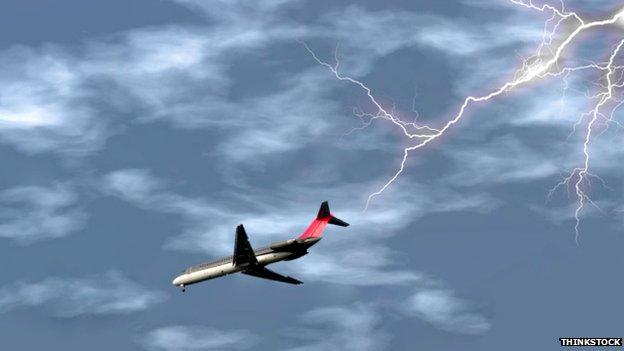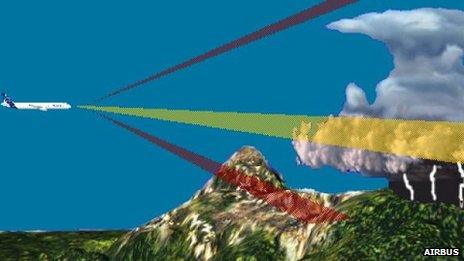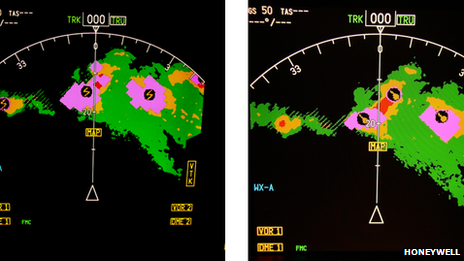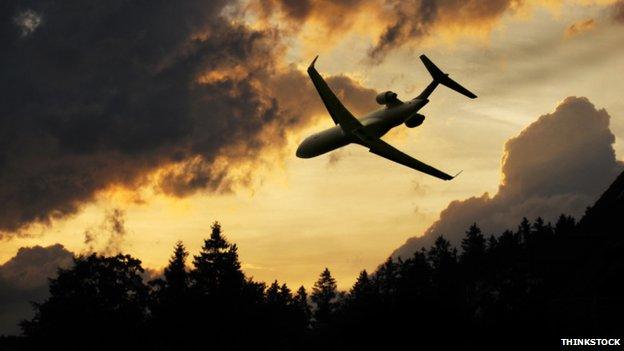Smart weather radar aims to help planes ride the storms
- Published

Thunderstorms usually mean turbulence, which can lead to injuries on board
There's a jolt - and passengers on a Qantas A380 en route from London to Sydney are bounced in their seats or sent tumbling in the aisles.
Severe turbulence caused by bad weather above the Indian Ocean in January this year resulted in seven people being treated for injuries, with four ending up in hospital.
This is not a rare occurrence. Frequent flyers know how unpleasant the irregular, and at times violent, motion of air currents can be.
Extreme weather can lead to injuries on board and damage to the plane, resulting in huge costs to airlines.
In the worst cases, bad weather can also play a role in a crash.
Although some air pockets are difficult to predict, pilots know that black storm clouds ahead often mean severe shaking and low visibility, as well as possible hail and lightning.
To spot these hazards and make the correct decision about pressing ahead or deviating, most large commercial and business jets are equipped with weather radar systems.
Partly thanks to this technology, pilots are able to notice thunderstorms early - but people still end up getting hurt. Last year, 80 passengers and cabin crew had turbulence-related injuries on commercial UK aircraft, says the UK Civil Aviation Authority.
And according to the US Federal Aviation Administration (FAA), nearly 60 people are hurt each year because of turbulence on US flights - there have even been a small number of fatalities. Bad weather also accounts for 70% of flight delays.
European plane manufacturer Airbus calls weather radars "essential equipment on modern airliners".
And now major aviation suppliers are busy upgrading this technology.

Weather radars could have either auto-tilt or auto-scanning functions
The weather radar that has been in use for some time is based on the so-called "tilt" technique.
A dish attached to the plane's nose or one of the wings scans the airspace in front, and the pilot has to manually adjust the tilt to check the weather above or below.
When workload is high, it is possible to misadjust the radar or misinterpret the data.
This could lead to the plane flying right into a dangerous cell or deviating too much, using more fuel than necessary.
But the new developments could help solve these issues, says Philip Brown, a cloud physicist from the Met Office, the UK's national weather service.
Auto-tilt and auto-scan techniques could be "a significant advance in on-board data processing and display systems", he says.
"By doing a lot of data storage and processing, the system is able to generate displays that can be used more intuitively than those from standard aircraft weather radar displays."
One feature involves warning if rain might have interfered with the radar beams, creating a distorted reading.

The next-generation weather radars could help pilots more accurately predict weather conditions ahead
"This could certainly be a useful new feature in navigating around intense thunderstorm activity," says Mr Brown.
3D weather map
US-based Honeywell, one of the biggest global aviation suppliers, has just rolled out its next-generation Intuvue system.
It automatically scans above, below and in front of an aircraft, relying on sensors to determine moisture content, temperature profile and other data in the storm cell ahead.
On-board computers then access the "reasonable probability" of external hazards - and display a three-dimensional weather map for the pilot in real time, says the firm's senior chief engineer, Ratan Khatwa.
"We've simplified the operation - our new radar is hands-free.

Honeywell's new weather radar uses icons to display weather hazards
"Instead of asking the pilot to manipulate tilt, the radar antenna automatically scans the airspace up to 320 miles in front and up to 60,000ft in altitude - a range greater than any other radar that exists today.
"And we interpret the image for the pilot, showing turbulence, hail and lightning icons."
The new system is already installed on a number of US aircraft, he adds.
'Relative threat'
Another big avionics maker, Rockwell Collins, plans to roll out a major upgrade to its weather radar technology in 2013.
The company says that more than 150 airlines around the world have installed its MultiScan Threat Detection system on more than 5,000 aircraft.
The new Boeing 787 Dreamliner will have it as well.
Next year, the software update will include the ability to perform real-time analysis of thunderstorm cells to indicate hail, lightning and potential turbulence, says the company's Steve Paramore.
The system will automatically adjust weather detection parameters depending on the time of day, time of year and the plane's geographic position.
"Our radar [works similarly] to the way modern jet fighters evaluate targets," says Mr Paramore.
"We initially evaluate using horizontal 2D sweeps and develop the track information for up to 40 thunderstorm threats. Based on their relative threat to the aircraft, cells are then analysed individually using vertical sweeps.
"This allows us to concentrate on the individual threats and provide a real-time threat analysis.
"In the future, it will also be important for the on-board radar to be shared with air traffic controllers so everyone has a common weather picture."

Weather radar systems are considered essential on modern aircraft
- Published14 May 2012

- Published21 March 2022

- Published10 May 2012